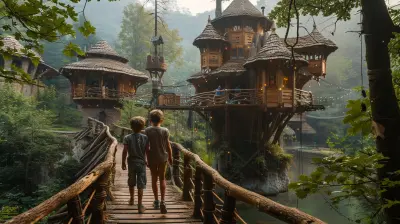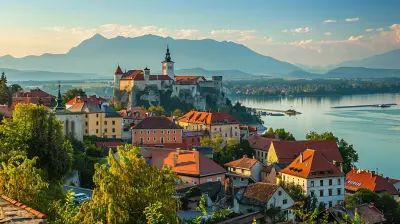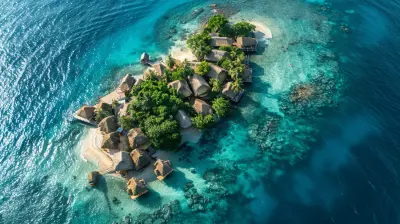The Iconic Architecture of Dubai's Burj Khalifa
22 October 2025
Have you ever stared in awe at a structure so massive, so futuristic, and so mind-blowingly tall that your brain needed a minute to catch up? That’s the kind of reaction the Burj Khalifa inspires. Towering above the Dubai skyline like a modern-day Tower of Babel, the Burj Khalifa isn't just another skyscraper—it's a symbol of ambition, innovation, and architectural genius.
So, if you're a travel junkie, architecture nerd, or just someone who's ever googled "tallest building in the world" (guilty!), this guide is your front-row seat to understanding what makes the Burj Khalifa a true architectural icon.
![]()
Breaking Records and Bending Minds: What is the Burj Khalifa?
Let’s start with the basics. The Burj Khalifa is the tallest building in the world. Period.Standing at a jaw-dropping 828 meters (2,717 feet), it pierces the sky with 163 habitable floors (and a few more non-usable ones just to flex), easily dominating Dubai’s already futuristic skyline.
But it's not just about height. The Burj Khalifa is a feat of modern engineering and cutting-edge architecture. It's not just tall—it's smart, sustainable, and stunning.
![]()
A Brief Backstory: How It All Began
Dubai isn't known for thinking small. Back in the early 2000s, the Emirate wanted to make a statement. The government launched the Downtown Dubai project and envisioned a vertical city within a city. Enter: the Burj Khalifa.Construction of the tower began in January 2004 and took about 6 years to complete. The tower was officially opened on January 4, 2010. Fun twist? It was originally called the "Burj Dubai." The name changed last minute to honor Sheikh Khalifa bin Zayed Al Nahyan, President of the UAE, whose financial support helped complete the construction during the 2008 financial crisis. Talk about building on gratitude!
![]()
The Mastermind Behind the Marvel: Architect Adrian Smith
Every iconic structure has a creative genius behind it. For the Burj Khalifa, that genius is American architect Adrian Smith of the firm Skidmore, Owings & Merrill (SOM). Smith's vision wasn’t just to build tall; it was to create an aesthetic legacy rooted in culture, engineering, and sustainability.And guess what? He totally nailed it.
![]()
Inspirations: Nature + Culture = Perfection
Even though it looks like something from a sci-fi movie, the design of the Burj Khalifa is deeply connected to Islamic architecture and nature. Have you ever seen a Hymenocallis flower? It's a desert plant with a central core and three symmetrical petals—it’s actually the design inspiration behind the Burj.The shape is not just pretty; it's practical. The triple-lobed footprint provides stability and reduces wind resistance. Plus, it mirrors traditional Islamic geometric patterns, which gives it an authentic Middle Eastern vibe. It's futuristic with roots in tradition—talk about architectural yin and yang.
Breaking Down the Design: What Makes It So Iconic?
Let’s get technical—but not too technical. We’re keeping this breezy, remember?1. Tapered Design
If you look closely, you'll notice the Burj Khalifa narrows as it rises. This is called a “tapered” design. It’s not just a style choice—it helps manage the crazy wind up there. You don’t want the world’s tallest building swaying around like a palm tree in a storm, right?2. Buttressed Core Structure
This part's a bit geeky but stick with me. The building uses a “buttressed core” structural system. Think of it like three legs of a tripod—each wing of the building supports the others. This design disperses stress and increases stability. It’s the architectural version of “teamwork makes the dream work.”3. Cladding System
The Burj Khalifa is wrapped in a shiny, reflective glass and aluminum cladding system. Not only does this make the tower look like it’s been dipped in liquid chrome, but it also keeps the interior cooler by reflecting the brutal desert sun. It’s beauty and brains in one shiny package!4. Vertical Transportation
Want to travel from ground to sky in under a minute? The Burj makes it possible. Its elevators are among the fastest in the world, zooming up at roughly 10 meters per second. With double-deck cabs and over 57 elevators, the Burj Khalifa is basically a vertical highway.
Sustainability in the Sky
Now, you might think a skyscraper this massive is a nightmare for the environment. Not so fast.The Burj Khalifa integrates several eco-friendly features. Here are a few that’ll make you nod in approval:
- Condensate Water Collection: The building collects water from the air conditioning system. This water (over 15 million gallons annually!) is used to irrigate the gardens below. Smart, right?
- Energy-Efficient Glass: All that shiny cladding? It’s specially designed to reduce heat and glare, keeping energy use down.
- Smart Cooling Systems: The AC is state-of-the-art, designed to cope with Dubai's frying-pan heat without guzzling power.
So yes, it’s possible to reach for the stars while still respecting Mother Earth.
Interiors That Dazzle
Step inside the Burj Khalifa, and the wonder doesn’t stop. Giorgio Armani himself designed the swanky Armani Hotel at the base of the tower. Think sleek lines, mood lighting, and luxury dripping from every surface.The residential and commercial spaces don’t skimp on glam, either. High ceilings, panoramic views, and no shortage of luxury finishes make this address one of the most prestigious in the world.
And the observation decks? Don’t even get me started. Perched at dizzying heights, they offer views that’ll make your Instagram followers jealous for days.
Burj Khalifa at Night: A Whole New Personality
If the Burj Khalifa during the day is impressive, at night it’s downright magical. The tower lights up with LED shows that are nothing short of jaw-dropping. From patriotic displays to New Year’s spectacles that rival Times Square, the Burj becomes a digital canvas in the sky.Can a building be a performer? In Dubai, it sure can.
Cultural Impact: More Than Just a Building
The Burj Khalifa isn’t just a place to work, live, or visit. It’s become a cultural icon.- It's been featured in Hollywood blockbusters like Mission: Impossible – Ghost Protocol
- It's inspired fashion shoots, music videos, and yes, even TikToks
- It’s a symbol of modern Middle Eastern ambition and progress
In short, it’s more than architecture—it’s a character in the story of Dubai.
Visiting the Burj Khalifa: Tips for Tourists
Planning to visit Dubai? Seeing the Burj Khalifa in person is a must. Here's how to make the most of it:1. Book in Advance
Tickets to observation decks (At The Top and At The Top Sky) sell out fast, especially during peak times like sunset. Book online to avoid disappointment.2. Choose Your Timing Wisely
Sunset gives you golden-hour photos and epic views, but it’s also the busiest. Mornings generally have fewer crowds. Your pick!3. Don’t Skip the Fountain Show
Right at the base of the Burj, the Dubai Fountain puts on a daily water-and-light show. Pair this with dinner at one of the surrounding restaurants, and you’ve got a magical evening lined up.4. Check Out the Souks and The Dubai Mall
Adjacent to the Burj is The Dubai Mall—a shopping behemoth with everything from an indoor ski slope to an aquarium. Cultural markets (souks) nearby offer a more traditional experience. It’s the perfect blend of past and future.What the Burj Khalifa Teaches Us
At first glance, the Burj Khalifa is just an insanely tall building. But zoom in, and you’ll see it's a celebration of vision, resilience, and innovation.It’s proof that dreaming big—really big—can turn into concrete reality (well, concrete and reinforced steel, technically). Whether you're into design, tech, culture, or just love a good skyscraper, the Burj is a modern marvel you can't ignore.
Final Thoughts
So, next time you see a photo of the Burj Khalifa, remember: it’s not just a tall piece of real estate. It's an architectural symphony of design, function, and culture playing in perfect harmony.In a way, the Burj Khalifa is like a giant middle finger to the concept of “impossible.” And honestly? We could all use a little of that boldness in our lives.
all images in this post were generated using AI tools
Category:
Must See LandmarksAuthor:

Tracie McAdams
Discussion
rate this article
1 comments
Elijah Whitaker
The Burj Khalifa is a stunning masterpiece of modern architecture. Its sheer height and innovative design truly embody Dubai's ambition and vision for the future. A must-see!
October 23, 2025 at 4:22 PM

Tracie McAdams
Thank you! The Burj Khalifa indeed represents Dubai's bold vision and has become a symbol of modern architectural excellence.


